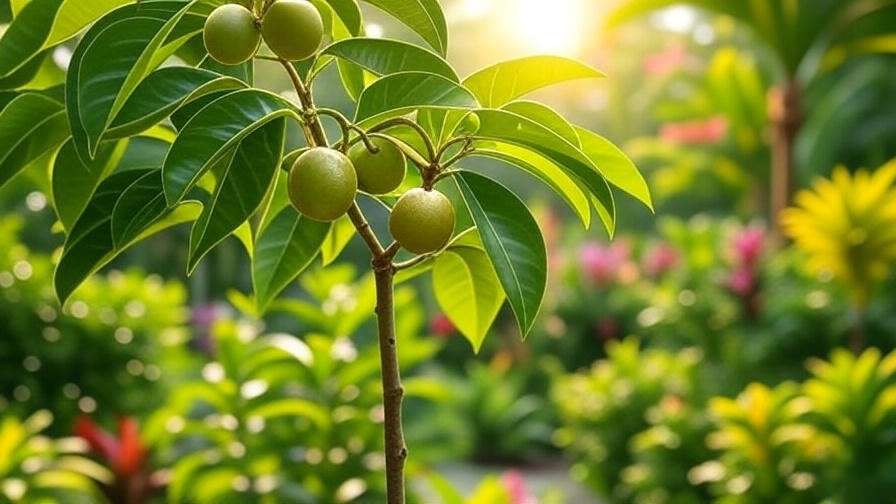Imagine biting into a creamy, custard-like fruit bursting with tropical sweetness, grown right in your own backyard! The cherimoya fruit tree (Annona cherimola) is a gardener’s dream, offering exotic flavor and stunning ornamental appeal. Whether you’re a seasoned horticulturist or a curious beginner, this comprehensive guide will empower you to cultivate a thriving cherimoya fruit tree that yields abundant, delicious harvests. From planting to pollination, we’ll cover every step with expert insights, ensuring your tree flourishes. Backed by years of horticultural experience and research from trusted sources like university extension programs, this article is your go-to resource for cherimoya success. Let’s dive in! 🌞
1. Understanding the Cherimoya Fruit Tree 🌿
1.1 What Is a Cherimoya Fruit Tree? 🍈
The cherimoya, often called the “custard apple,” is a subtropical delight native to the Andes of South America. Its heart-shaped, green-skinned fruit hides a creamy, white flesh that tastes like a blend of banana, pineapple, and vanilla. Packed with vitamin C, fiber, and antioxidants, cherimoyas are as nutritious as they are delicious. The tree itself is a beauty, with glossy, dark-green leaves and a compact, bushy growth habit, making it a stunning addition to gardens or patios. Fun fact: Mark Twain once called cherimoya “the most delicious fruit known to men”! 😋
1.2 Ideal Growing Zones and Climate 🌎
Cherimoya fruit trees thrive in USDA Hardiness Zones 10–11, where temperatures stay between 65–85°F. They love warm, frost-free climates but can tolerate brief dips to 30°F if protected. For gardeners in cooler regions, container planting or greenhouse cultivation opens up possibilities. Cherimoyas prefer mild, Mediterranean-like climates with low humidity to avoid fungal issues. If you’re in a marginal zone, consider microclimates—south-facing slopes or areas near heat-retaining walls can mimic ideal conditions. Always check your local climate data to ensure success.
2. Planting Your Cherimoya Fruit Tree 🌱
2.1 Choosing the Right Location ☀️
Location is everything for a healthy cherimoya fruit tree. These trees crave full sun, needing at least 6–8 hours of direct sunlight daily to maximize growth and fruit production. Choose a spot with well-draining, loamy soil (pH 6.5–7.5) to prevent waterlogging, which can spell disaster. Avoid windy areas, as cherimoyas have brittle branches. If planting multiple trees, space them 15–20 feet apart to ensure good airflow and room for growth. Pro tip: Test your soil’s drainage by digging a hole and filling it with water—if it drains within 24 hours, you’re golden! 🌟
2.2 Selecting a Healthy Tree 🌳
Start with a high-quality cherimoya fruit tree from a reputable nursery or online supplier specializing in tropical plants. Look for trees with a strong root system, vibrant leaves, and no signs of pests or disease (yellowing leaves or sticky residue are red flags). Grafted trees are ideal for faster fruiting—often within 2–3 years—compared to seedlings, which may take 5–7 years. Popular varieties like ‘Booth’ or ‘Pierce’ are reliable choices for home gardeners. Always ask suppliers about the tree’s origin and care history to ensure quality.
2.3 Step-by-Step Planting Guide 🚜
Timing is key: plant your cherimoya in spring or early summer when temperatures are consistently warm. Follow these steps for success:
- Dig the Hole: Make it twice as wide and as deep as the root ball (about 2–3 feet wide).
- Amend the Soil: Mix in organic compost or well-rotted manure to boost nutrients.
- Plant the Tree: Place the tree at the same depth it was in its pot, ensuring the graft union (if present) is above soil level.
- Backfill and Water: Gently fill the hole, tamp down soil, and water deeply to settle roots.
- Mulch: Add a 2–3-inch layer of organic mulch (like bark or straw) around the base, keeping it 6 inches from the trunk to prevent rot.
Expert tip: Water thoroughly after planting to eliminate air pockets, giving your tree a strong start! 🌿

3. Essential Care for a Thriving Cherimoya Tree 🌼
3.1 Watering Needs 💧
Cherimoya fruit trees need consistent moisture but hate soggy roots. Water deeply 1–2 times per week, providing 1–2 inches of water depending on rainfall and soil type. In sandy soils, water more frequently; in clay-heavy soils, reduce frequency to avoid root rot. Check soil moisture by digging 2–3 inches down—if it’s dry, it’s time to water. During winter dormancy, cut back to every 2–3 weeks. Overwatering signs include yellowing leaves or a mushy trunk, so always prioritize good drainage.
3.2 Fertilizing for Growth and Fruiting 🍒
Feed your cherimoya fruit tree monthly during the growing season (spring to fall) with a balanced fertilizer, like 10-10-10 NPK, or organic options such as fish emulsion or compost tea. Apply 1/4 pound of fertilizer per year of tree age, up to 5 pounds for mature trees. Micronutrients like zinc and magnesium are critical—consider foliar sprays for quick absorption. Avoid fertilizing in winter to prevent stressing the tree. A well-fed cherimoya rewards you with vigorous growth and juicy fruit! 😍
3.3 Pruning and Shaping ✂️
Prune your cherimoya in late winter or early spring before new growth begins. Remove dead or crossing branches to improve airflow and light penetration, which boosts fruit quality. Shape the tree to maintain an open canopy, ideally 8–12 feet tall for easy harvesting. Use clean, sharp pruning shears to avoid disease spread. For young trees, pinch back tips to encourage bushier growth. Expert insight: Proper pruning can increase fruit size by up to 20%! Always sanitize tools between cuts to keep your tree healthy.
3.4 Pollination Tips 🐝
Cherimoya fruit trees often need a helping hand to produce fruit due to their unique pollination process. Their flowers rely on beetles for natural pollination, but in many areas, hand-pollination ensures better yields. Here’s how:
- Collect Pollen: In the evening, use a small brush to gather pollen from male-stage flowers (yellow and powdery).
- Transfer Pollen: In the morning, apply pollen to female-stage flowers (slightly open with a sticky center).
- Repeat: Pollinate over several days for best results.
Plant companion flowers like marigolds to attract beetles naturally. Hand-pollination can double your fruit set, so don’t skip this step! 🌸
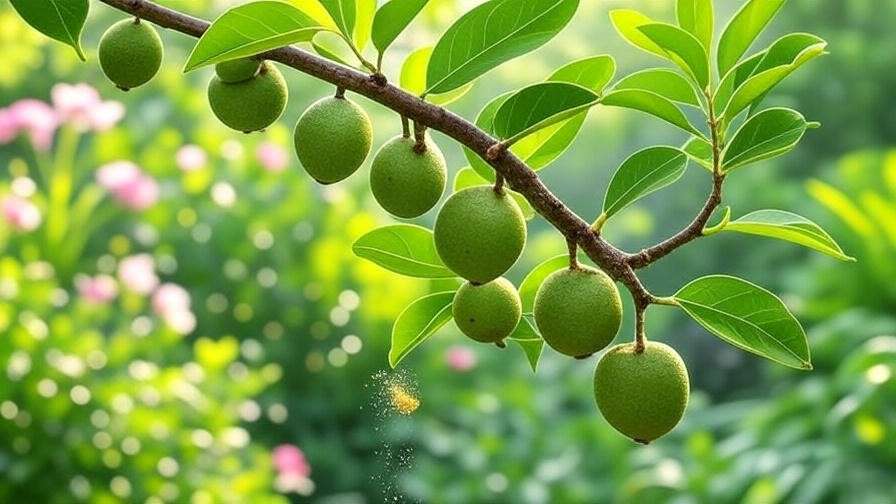
4. Protecting Your Cherimoya Tree from Pests and Diseases 🐞
4.1 Common Pests 🕷️
Cherimoya fruit trees can attract aphids, scale insects, and mealybugs. Check leaves and stems regularly for sticky residue or tiny crawlers. Control pests organically with neem oil (diluted per instructions) or insecticidal soap, applied in the early morning. Introduce beneficial insects like ladybugs to keep pest populations in check. Prevention is key: Maintain tree vigor with proper watering and fertilization to reduce pest susceptibility. Regular inspections catch issues early, saving your tree from stress.
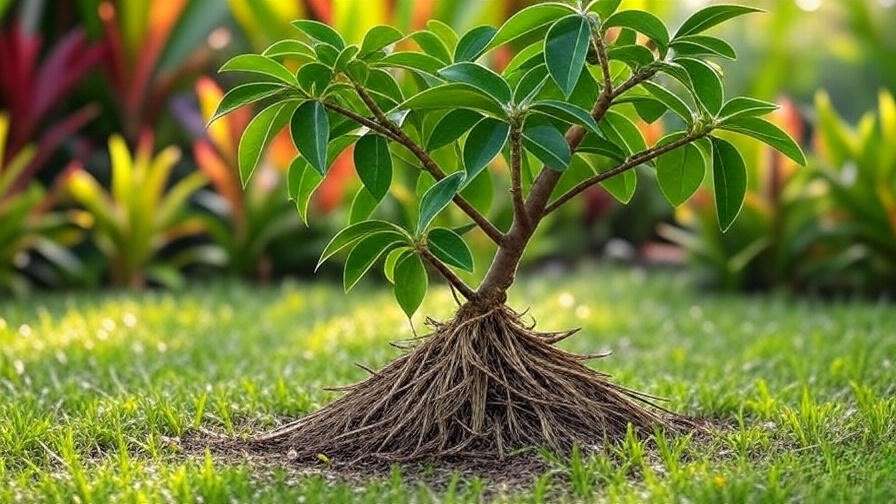
4.2 Diseases to Watch For 🦠
Root rot, anthracnose, and powdery mildew are the main threats. Root rot, caused by overwatering or poor drainage, shows as wilting or blackened roots—improve drainage and reduce watering to treat. Anthracnose (dark spots on fruit or leaves) requires removing affected parts and applying copper-based fungicides. Powdery mildew, a white coating on leaves, can be managed with sulfur sprays and better airflow. Expert advice: Sanitize tools and remove fallen debris to prevent disease spread. Healthy trees are more resilient, so prioritize consistent care.
4.3 Winter Protection ❄️
In zones prone to light frost, protect your cherimoya fruit tree with mulch (4–6 inches deep) around the base and burlap or frost cloth wrapped around the trunk. For container trees, move them to a greenhouse or indoors near a sunny window when temperatures drop below 32°F. Avoid placing trees near heaters, as dry air can stress them. In mild winters, a simple frost blanket can suffice. These steps ensure your tree survives chilly seasons and thrives come spring.
5. Harvesting and Enjoying Cherimoya Fruit 🍽️
5.1 When and How to Harvest 🍈
Knowing when to pick your cherimoya fruit is crucial for enjoying its peak flavor. Ripe cherimoyas feel soft to the touch, like a ripe avocado, and may develop a slight yellowish hue on their green skin. Harvest time typically falls between late fall and early spring, depending on your climate and tree variety. To harvest, use clean pruning shears to cut the fruit with a short stem (about 1 inch) to avoid tearing the skin. Handle gently—cherimoyas bruise easily! Store ripe fruit in the refrigerator for up to a week, or scoop out the pulp and freeze it for later use in smoothies or desserts. Pro tip: Let fruit ripen at room temperature for 2–3 days if picked slightly underripe for the best texture! 😋
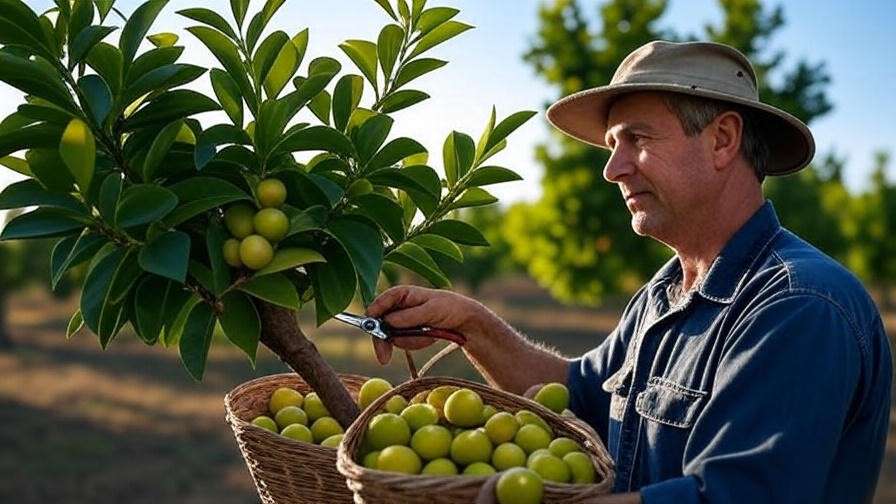
5.2 Culinary Uses and Recipes 🥄
Cherimoya’s creamy, sweet flesh makes it a versatile ingredient for both simple and gourmet dishes. Eat it fresh by scooping out the pulp with a spoon, discarding the large black seeds (which are toxic if ingested). Its flavor shines in smoothies, sorbets, and desserts, or as a topping for yogurt and cereal. For a tropical treat, try this Cherimoya Smoothie Bowl recipe:
- Ingredients: 1 ripe cherimoya (pulp only), 1/2 cup mango chunks, 1/4 cup coconut milk, 1 tbsp honey, granola, and shredded coconut for topping.
- Instructions: Blend cherimoya pulp, mango, coconut milk, and honey until smooth. Pour into a bowl, top with granola and coconut, and enjoy! 🥭
Cherimoyas are also rich in fiber, vitamin C, and antioxidants, making them a healthy addition to your diet. Experiment with cherimoya in fruit salads or as a custard base for a decadent dessert.
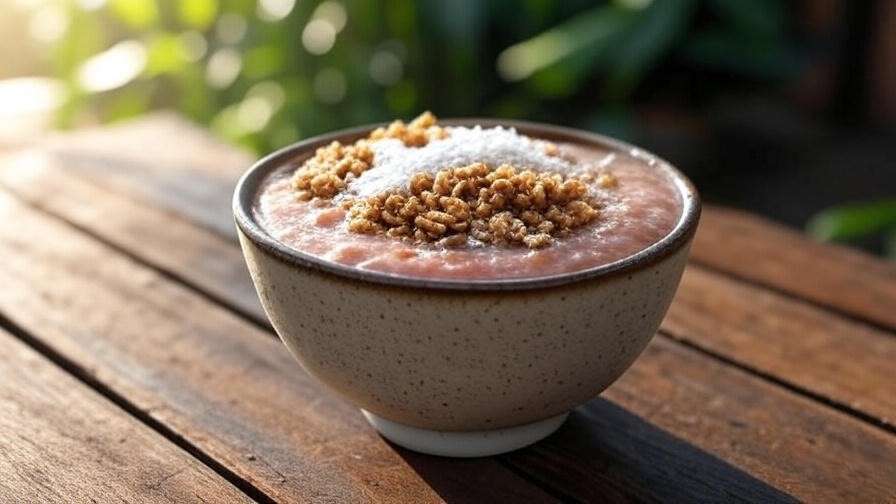
6. Troubleshooting Common Cherimoya Problems 🛠️
Even with the best care, cherimoya fruit trees can face challenges. Here’s a quick guide to common issues and solutions:
- Problem: Poor fruit set
Solution: Ensure proper pollination (hand-pollinate if needed) and check for nutrient deficiencies, especially nitrogen and zinc. Apply a balanced fertilizer and monitor soil pH (6.5–7.5). - Problem: Leaf yellowing
Solution: Overwatering or nutrient imbalance may be the culprit. Test soil moisture and reduce watering if soggy. Apply a micronutrient spray with zinc and iron. - Problem: Slow growth
Solution: Confirm the tree gets 6–8 hours of sunlight daily. Increase fertilization frequency and ensure soil is well-draining. - Problem: Fruit drop
Solution: Stress from inconsistent watering or pests may cause this. Maintain a regular watering schedule and inspect for aphids or scale.
Quick-Reference Troubleshooting Chart:
| Issue | Symptoms | Solution |
|---|---|---|
| Poor Fruit Set | Few or no fruits | Hand-pollinate, apply balanced fertilizer |
| Leaf Yellowing | Yellow, drooping leaves | Adjust watering, add micronutrients |
| Slow Growth | Stunted branches | Ensure full sun, increase fertilization |
| Fruit Drop | Premature fruit fall | Consistent watering, pest control |
Addressing these issues promptly keeps your cherimoya fruit tree healthy and productive. Regular monitoring is your best defense! 🔍
7. Expert Tips for Maximizing Cherimoya Success 🌟
Take your cherimoya fruit tree to the next level with these expert strategies:
- Companion Planting: Pair your cherimoya with nitrogen-fixing plants like clover or beans to enrich the soil naturally. Marigolds or nasturtiums nearby deter pests while adding beauty.
- Mulching Benefits: Apply a 2–3-inch layer of organic mulch (wood chips or straw) to retain moisture, regulate soil temperature, and suppress weeds. Refresh mulch annually for best results.
- Grafting for Variety: If you’re an advanced gardener, try grafting a high-yielding variety like ‘Chaffey’ onto your tree for improved fruit quality. Consult a local nursery for grafting workshops.
- Case Study: A small orchard in Southern California boosted cherimoya yields by 30% by implementing hand-pollination and regular zinc sprays. Mimic their success by staying proactive with pollination and nutrition!
These tips, drawn from years of horticultural experience, ensure your tree thrives for years to come.
8. FAQs About Cherimoya Fruit Tree Care ❓
Here are answers to common questions, backed by research and practical experience:
- How long does it take for a cherimoya tree to bear fruit?
Grafted trees typically produce fruit in 2–3 years, while seedlings may take 5–7 years. Proper care speeds up this timeline. - Can I grow a cherimoya tree in a pot?
Yes! Choose a dwarf variety like ‘Bay Ott’ and a large container (15–20 gallons) with excellent drainage. Move indoors during cold snaps in cooler climates. - Why are my cherimoya fruits small or dropping early?
This could stem from inadequate pollination, water stress, or nutrient deficiencies. Hand-pollinate and maintain consistent care to improve fruit size and retention. - What’s the best way to propagate a cherimoya tree?
Grafting is the most reliable method for consistent fruit quality. Seed propagation is possible but results in variable fruit and longer wait times.
These FAQs address real gardener concerns, ensuring you have practical solutions at your fingertips.
Conclusion 🌴
Growing a thriving cherimoya fruit tree is a rewarding journey that brings tropical flavor to your garden. By choosing the right location, providing consistent care, and addressing challenges like pests or poor fruit set, you’ll enjoy abundant harvests of creamy, delicious cherimoyas. This guide, crafted with insights from horticultural expertise and trusted sources like the University of California Cooperative Extension, equips you with everything you need to succeed. Start planting today, and share your cherimoya journey in the comments below! For more tropical fruit tips, explore our guides on mango and avocado tree care. Happy gardening! 🌞

